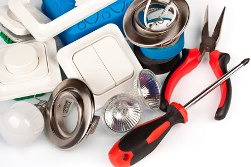Categories: Featured Articles » Electrician at home
Number of views: 26288
Comments on the article: 1
Ten rules affecting the reliability of wiring
 Reliability in the installation and installation of electrical wiring depends on many factors, primarily on correctly selected wires and cables, electrical products, installation quality. Here are a few important rules that you must follow, since the reliability of the wiring performed depends on them.
Reliability in the installation and installation of electrical wiring depends on many factors, primarily on correctly selected wires and cables, electrical products, installation quality. Here are a few important rules that you must follow, since the reliability of the wiring performed depends on them.
1. Reliability of electrical wiring is determined by a number of factors and, first of all, by the correct choice of wires and cables in accordance with environmental conditions and load current.
2. You cannot use hidden and open wiring on heated surfaces, since heating the insulation above acceptable sharply reduces its service life.
3. The electrical wiring must be fixed on the building structures of buildings without reducing their strength. Improper wiring may cause chips and cracks. Particularly dangerous strobing walls with long gates. Do not ditch the ceiling.
4. In places with an ambient temperature that differs from the calculated one (25 aboutC), wires and cables must have heat-resistant insulation or current loads on them must be recounted and changed. The temperature of the conductors of wires and cables should not exceed the permissible values, since excess temperature leads to the destruction of the insulation of the wire or cable.
5. When laying wires in plastic boxes they should not have any burrs, sharp edges or other defects that could damage the insulation of wires and cables. The design and installation method of the boxes must be such that moisture does not accumulate in them.
6. When laying wires and cables in pipes they must have an inner surface that does not damage the insulation of the wires when tightened and a corrosion-resistant coating on the outside and inside. The method of installation of pipes should exclude the accumulation of moisture in them. The ends of the pipes must be closed with plugs before tightening the wires. End caps prevent debris from entering the pipe.
7. Connections and branches of wires and cables should be accessible for inspection and repair. All connections and branch wires must be performed only in connecting and junction boxes. In the places of connection of the conductors of wires, it is necessary to provide for a supply of wire in order to ensure the reliability of the repeated connection. The insulation of the joints and branches should be equivalent to the insulation of the conductors of the connected wires and cables.
8. Wires in the place of entry into the fixtures should not be subjected to mechanical damage, and the contacts of the lamp holders should be unloaded from mechanical stress. The screw-type socket for lamp holders must be connected to the neutral wire.
9. The branching of wires from the supply networks and risers should be carried out using branch clamps. Cutting of supply networks and risers is not allowed.
10. Wires in the places of exit from boxes, metal and plastic pipes, channels of building structures should be protected from damage by bushings or PVC pipe.
See also at e.imadeself.com
:
